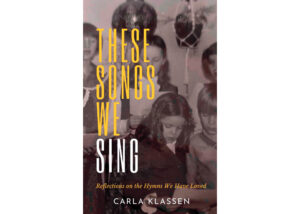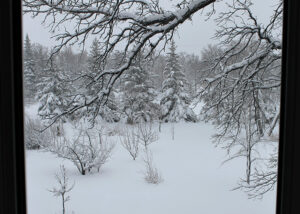“O come, O come Emmanuel,” a stock dirge of Advent, comes from a house of pain that once was, still is, and shall be again. The hymn is haunting. (HWB #172)
Friends grinding grain are ripped apart. One remains and the other is taken. (Matt. 24:36-42)
An expectant teenager sings a song of revolution. The hungry feast in the dining room of a grand house—the owners have fled. (Luke 1:46-55)
When asked a simple question about big stones and a big city, Jesus warns of war, earthquakes, persecution, and suggests running for the hills. (Mark 13:1-27)
John the Baptist screams about an axe, trees and a fire: spiritual deforestation on a grand scale. (Matt. 3:1-12)
With these and other Advent lectionary standards, we are ushered into something quite the opposite of innocent anticipation of what is under the Christmas tree. In Advent I am held in dirges. I picture myself losing a friend in an instant. As one of the rich, I am fleeing my festive dining room while others are enjoying my (former) largesse. I am running for the hills, which are burning.
Even Lent, of which Advent is meant to be a shorter, less penitent version, seems like a piece of cake compared to all of this apocalyptic drama.
Richard Lischer, in an article entitled, “The Limits of Story,” suggests that being disturbed by Advent is a good thing. Lischer is skeptical of our North American Christian middle-class infatuation with stories that end well. He wonders if our appetite for the predicable plot line is yet another way to falsely assure ourselves that all is well. The “closure” we feel at the end of a good story, sermon, or worship service may actually lull us into thinking that all stories end well. We also become blind to the many “unresolved plots” around us.
Are we guilty of too much closure in Biblical storytelling, singing, and preaching? In one hour of worship, problems are solved, plots resolved—and we can go living our lives as if all is well. Abraham and Sarah could not have children, but then she bore a son; the Israelites were stuck in the desert and then eventually they landed in a land of milk and honey; stories that begin with a blind man and a bleeding woman end in healing. The cross of Friday is followed quickly by the Sunday of resurrection.
We love these stories, and so we should. God is active in bringing new life, new land, healing, and loving community. But plot lines are not all the same, good resolutions often bring collateral damage, and God’s good news is not automatic, predictable, or necessarily “nice.” God mercy is bigger than the resolution of the plots we suppose that we are in.
Advent texts force the worshipping congregation to stay in that part of story where the trouble at hand is not yet—and perhaps never will be—resolved. The world over, in our homes, and indeed in many biblical accounts, stories do not end well: The hungry are not fed, young people die, the war goes on, women remain barren, the family dysfunction goes on in perpetuity, and the refugees remain in the camps. Many plot lines remain unresolved. In Advent we are forced to stay in that disturbing place of longing, praying, and singing dirges.
I welcome Advent with its disturbing hymns and texts. I marvel at those who dare to sing “rejoice, rejoice, Emmanuel,” in a house of pain. Advent hymns and texts disturb me into believing and hoping in God in the myriads of places where much remains unresolved.
Allan Rudy-Froese is Assistant Professor of Christian Proclamation at Anabaptist Mennonite Biblical Seminary, Elkhart, Indiana. His doctorate is in homiletics—the art and theology of preaching. Allan has been planning, preaching, telling stories, and singing in Advent for more than 25 years.








Leave a Reply
You must be logged in to post a comment.